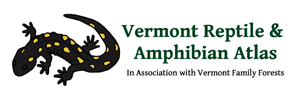Terrapene carolina
Identification
The Eastern Box Turtle has a highly domed carapace (shell covering the back) that is usually 4.5-6 inches long. The carapace is smooth on the rear edge, but it does have a slight mid-dorsal (back) keel. They are highly variable in pattern, but generally the shell has yellow and orange markings on a darker background and the head and the legs are mostly dark and mottled with yellow and orange. The males have orange or red eyes. The plastron is hinged on the anterior side of the bridge, which enables the plastron to bend and the turtle to completely enclose itself in its shell.
Native Box Turtles have four toes on their hind feet, distinguishing them from many of the released Box Turtles, which have three toes on their hind feet.
Get more detailed identification and life history information by downloading the chart here.
You can learn more about this species and see some video footage by checking out this clip from our Rattlers, Peepers & Snappers DVD. Find answers to some frequently asked questions about turtle nesting, what to do if a turtle nests on your property, and how to protect turtle nests at this link.
Range/Habitat

[ click image to zoom | download printable PDF ]

[ click image to zoom | download printable PDF ]
Eastern Box Turtles in Vermont are generally assumed to be released pets. The nearest known populations are about 10 miles south of us in Massachusetts, and 20 miles west in New York.
Eastern Box Turtles are entirely terrestrial and are often found in open woods and brushy fields.
Status
Although Vermont Eastern Box Turtles are generally assumed to be released pets, a cluster of reports from the southern Connecticut River Valley suggests the possibility of a native population. No young or eggs have been reported. Therefore, this species is classified as unconfirmed in the state. Please report all sightings of this species in Vermont. Take photos if possible.
Additional Photos
More Info
- Terrapene carolina at Animal Diversity website
- Terrapene carolina Savanah River Ecological Laboratory
- Terrapene carolina New Hampshire Fish and Game
- Terrapene carolina Wikipedia
- Terrapene carolina Department of Defense PARC Species profile video series
Species summary written by Ariel K. Mck. Burgess.







